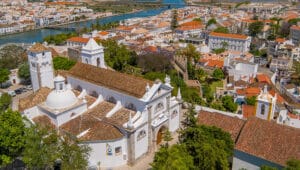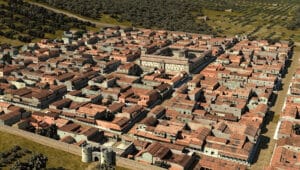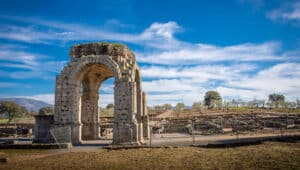In almost every village, town and city in Portugal, you will find sections of the unique traditional Calçada Portuguesa pavement made up of black and white decorative cobblestones.
This masonry art craft is unique to Portugal and an iconic part of Portuguese culture and craftsmanship. It has its first origins from the Romans who used stones and mosaics to make their roads, and then the Moors, during their time here between the eighth and 12th centuries, added to the craft by making geometric patterns on their floors.
However, it was in the 19th century that the art developed further as the first large calçada area was created in 1842 in the Castle of São Jorge in Lisbon.
Governor Eusébio Pinheiro Furtado employed prisoners to make up the paving in a wave-like pattern using white limestone rocks contrasting with black basalt rocks. The pattern was to symbolise the sea waves in honour of Portugal’s maritime history.
Later, the Praça do Rossio, Lisbon’s central square, was also paved with these same waves which have become so renown they also appear along Rio de Janeiro’s Copacabana beach.
Soon, other towns and cities across Portugal took up the inspirational idea and paved designs appeared everywhere. Designs can be almost anything but are often in reference to Portugal’s maritime history with caravels, coats of arms, historical symbols as well as flora or fauna motifs and geometric patterns. The use of Calçada Portuguesa also spread to former Portuguese colonies and cities all over the world.
The creation process is always the same. Once the design has been decided, a template is often prepared and the small irregular or squarish-shaped stones are gathered in piles on the site where the ground has previously been levelled and compacted with sand and fine gravel.
Craftsmen (I wonder if any women have ever chosen this profession?) known as calceteiros sit in all weathers, skilfully and carefully placing each stone, by hand, next to those already in place, thus building up the mosaic design. They chip away any bits as necessary to make the stones fit snuggly together.
Once all are in place, the stones are compacted and the spaces between them are filled with more fine gravel or cement to ensure durability. This process has ensured that the calçada lasts for decades.
If you take the time to watch one of the men diligently working, it looks easy to place the stones together to make the pictures and patterns as they do it so quickly. However, it takes a lot of skill. When one of our calçada stones has been raised up by tree roots, I have tried to put it back and failed as it just never seems to refit properly in the hole!
Did you know that calçada is also used indoors and it is referred to as calçada polida, polished pavement? The rough irregular paving is polished into a smooth elegant surface which enhances the beauty of the stones and gives a terrazzo flooring effect. It can be shiny or matt and is one of my favourite flooring styles.
Typically, white limestone is used along with the contrasting black basalt rock and, in the islands of Azores and Madeira, sometimes red rocks are used to add colour to a design.
However, whilst beautiful, these paved calçadas are extremely dangerous to walk on as they are easily damaged causing uneven paving and get very slippery when wet. I have no doubt that many an unsuspecting tourist has caught her high heels in the cracks and I remember how hard it was to push a pram on the pavements.
To ease the dangers, some councils are making a narrow solid pathway through the calçada and I did read that Porto replaced its city centre calçadas for large granite slabs in 2005.
The calçada around our farm is being dislodged by tree roots and regularly little volcanoes of gravel appear as entrances to ant nests, as we seem to be living on an ant hill. I find them quite fascinating but, of course, they are damaging our paving!
Calçadas require regular maintenance to level the area, to replace broken or dislodged stones, to be polished or to remove the profusion of weeds that like growing in the cracks. 
There are fewer and fewer individuals choosing to train to be a calceteiro due to the labour intensity and low pay.
In 2006, Lisbon unveiled a memorial to calceteiros at Praça Dom Pedro IV, two bronze sculptures depicting men working on a calçada, one placing the stones and one levelling the ground.
In 2015, Lisbon Council did promote an initiative to train more calceteiros, but, mostly nowadays, they are employed in maintaining existing pavements.
In 2020, in Lisbon, there were just 18 active workers. Added to the fact that some councils are under pressure to replace the dangerous paving, it is worrying that this beautiful art could die out.
However, in 2021, the Calçada Association successfully subscribed calçada to be recognised as part of the Intangible Cultural Heritage of Portugal, which recognises traditions or living expressions (crafts, celebrations, music, cultural practices etc.) inherited from our ancestors and passed through the generations.
This was viewed as a step towards the application to UNESCO for calçada to be recognised as important Intangible Cultural Heritage/World Heritage Classification, similar to what happened successfully with Fado music.
The application is meant to further promote the importance of the profession of calceteiros and to preserve this traditional unique cultural art form.
To be eligible, calçada must meet strict UNESCO criteria for safeguarding cultural diversity and promoting awareness of its significance. A successful application would reflect Portugal’s rich heritage and help to preserve it for future generations.
Calçada Portuguesa is more than just a pavement with a pretty design. It is a symbol of Portuguese history and craftsmanship, shaped by the hands of skilled artisans. Found not only in Portugal but also in South America, Europe and Asia, its designs create a lasting connection between our past and cultures across the world.
This unique art form stands as a testament to tradition and identity, uniting generations through its beauty and legacy. Just be sure to wear flat rubber-soled shoes when walking on it!
So now you know!
























